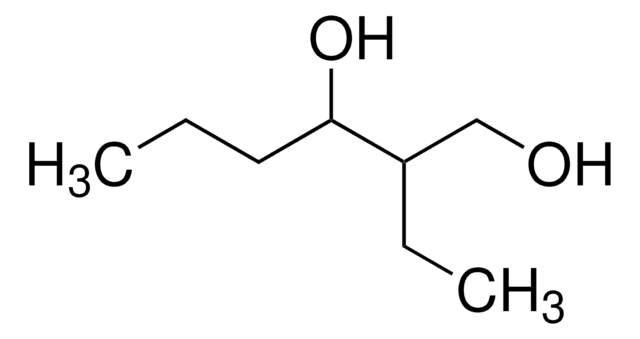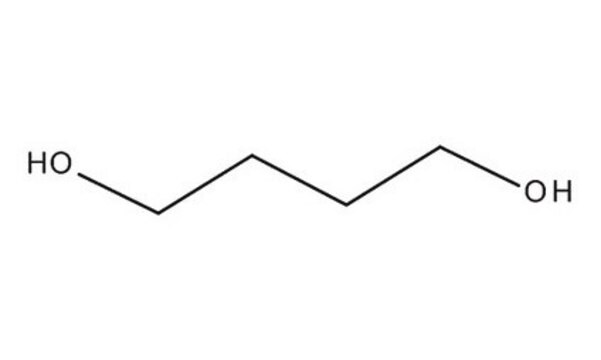H11807
1,6-Hexanediol
97%
Sinónimos:
Hexamethylene glycol
Iniciar sesiónpara Ver la Fijación de precios por contrato y de la organización
About This Item
Fórmula lineal:
HO(CH2)6OH
Número de CAS:
Peso molecular:
118.17
Beilstein:
1633461
Número CE:
Número MDL:
Código UNSPSC:
12352100
ID de la sustancia en PubChem:
NACRES:
NA.22
Productos recomendados
presión de vapor
0.53 mmHg ( 20 °C)
Análisis
97%
temp. de autoignición
608 °F
lim. expl.
16 %
bp
250 °C (lit.)
mp
38-42 °C (lit.)
cadena SMILES
OCCCCCCO
InChI
1S/C6H14O2/c7-5-3-1-2-4-6-8/h7-8H,1-6H2
Clave InChI
XXMIOPMDWAUFGU-UHFFFAOYSA-N
¿Está buscando productos similares? Visita Guía de comparación de productos
Categorías relacionadas
Aplicación
1,6-Hexanediol is generally used to introduce C6-spacer in molecular substrates. It is also widely used in the synthesis of various polyesters.
Código de clase de almacenamiento
11 - Combustible Solids
Clase de riesgo para el agua (WGK)
WGK 1
Punto de inflamabilidad (°F)
215.6 °F - closed cup
Punto de inflamabilidad (°C)
102 °C - closed cup
Equipo de protección personal
Eyeshields, Gloves, type N95 (US)
Elija entre una de las versiones más recientes:
¿Ya tiene este producto?
Encuentre la documentación para los productos que ha comprado recientemente en la Biblioteca de documentos.
Los clientes también vieron
Melt-phase synthesis and properties of triptycene-containing copolyesters.
Liu, Yanchun et al.
Macromolecules, 44(11), 4049-4056 (2011)
Liquid crystalline phthalocyanine-fullerene dyads.
Ince, Mine et al.
Journal of Materials Chemistry, 21(5), 1531-1536 (2011)
A series of furan-aromatic polyesters synthesized via direct esterification method based on renewable resources.
Jiang, Min et al.
Journal of Polymer Science Part A: Polymer Chemistry, 50(5), 1026-1036 (2012)
Kifah Nasr et al.
Polymers, 12(9) (2020-08-28)
Among the various catalysts that can be used for polycondensation reactions, enzymes have been gaining interest for three decades, offering a green and eco-friendly platform towards the sustainable design of renewable polyesters. However, limitations imposed by their delicate nature, render
H D Durham et al.
Muscle & nerve, 11(2), 160-165 (1988-02-01)
We reported previously that 2,5-hexanedione (2,5-HD), the neurotoxic metabolite of methyl-n-butylketone (MnBK) and n-hexane, induced aggregation of intermediate filaments of the vimentin type in cultured fibroblasts. To determine if these findings have relevance to the mechanism by which these hexacarbons
Nuestro equipo de científicos tiene experiencia en todas las áreas de investigación: Ciencias de la vida, Ciencia de los materiales, Síntesis química, Cromatografía, Analítica y muchas otras.
Póngase en contacto con el Servicio técnico













